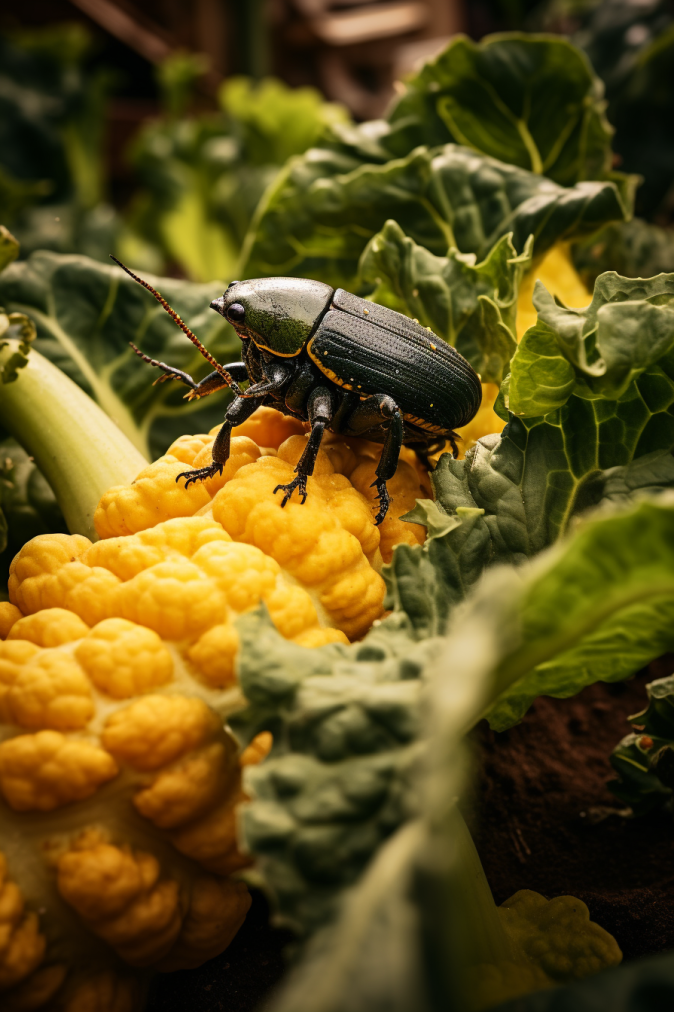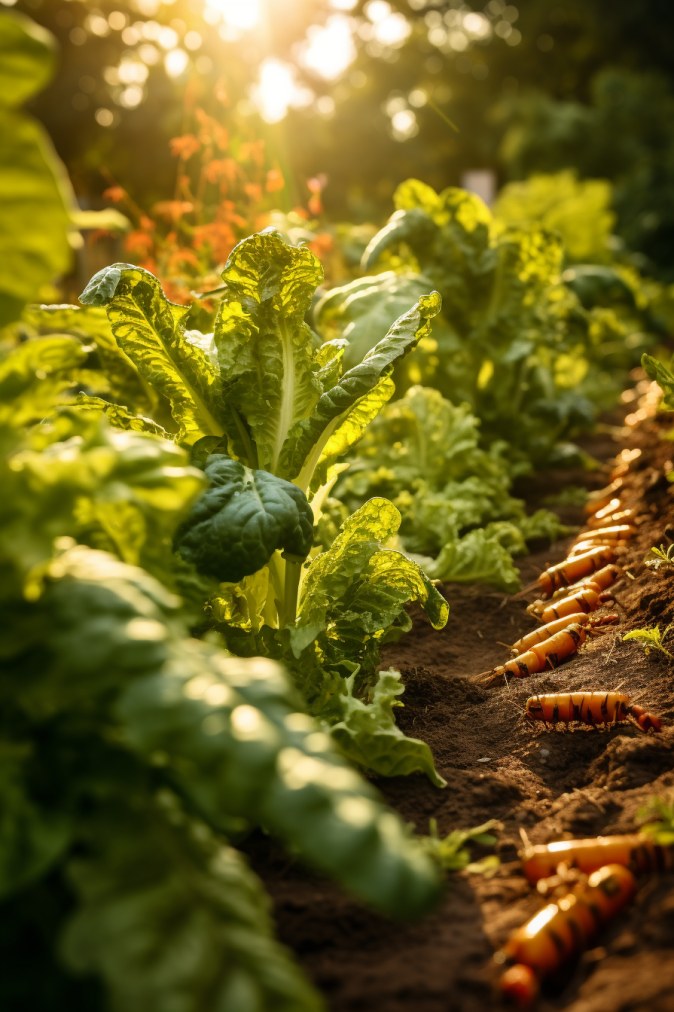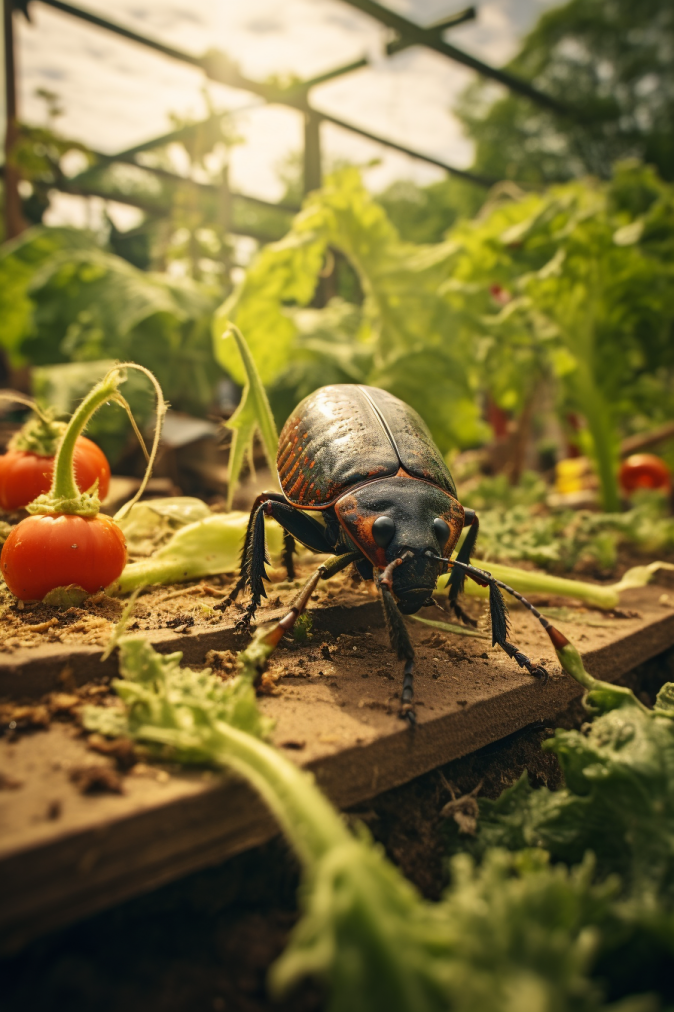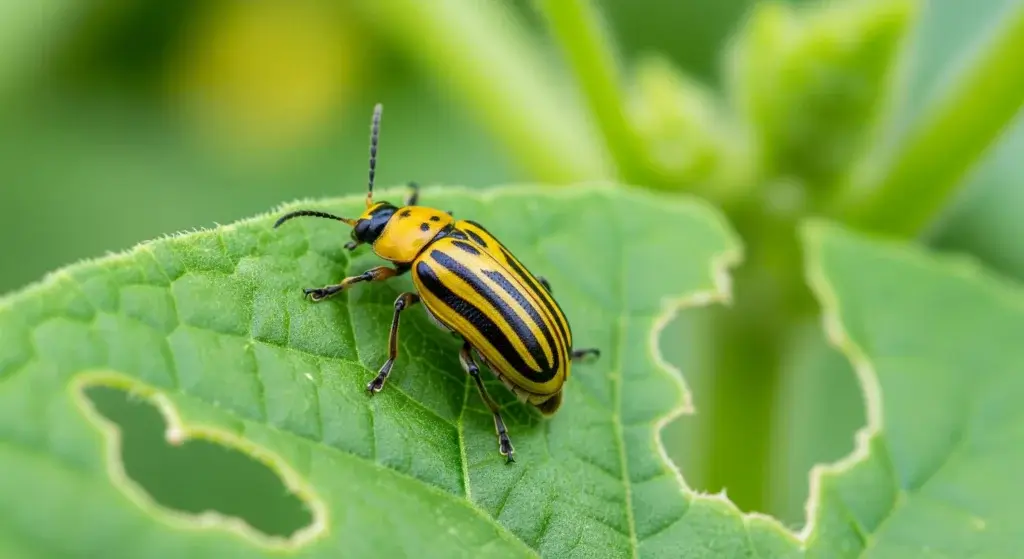
Picture strolling into your garden and being met by a lush, flourishing array of veggies, untouched by bothersome intruders.
Achieving this idyllic scene requires embracing eco-friendly pest control techniques.
Within this guide, we’ll delve into the significance of these methods and provide practical ways to integrate them into your very own vegetable patch.
What’s the Importance of Choosing Nature-Friendly Methods?
Choosing nature-friendly pest control methods transcends a mere decision; it’s a dedicated effort to maintain the delicate equilibrium within your garden’s ecosystem.
Unlike their harsh chemical counterparts, these methods offer a multifaceted approach that not only shields your plants but also nurtures them, ensuring a safer and healthier environment for your loved ones and the wildlife around them.
Here’s why these methods matter:
Ecosystem harmony
Nature-friendly methods work in harmony with the environment.
They respect the interconnectedness of living organisms in your garden, promoting a balanced ecosystem where pests and beneficial insects coexist without upsetting the natural order.
- Read also: A Guide to Natural Pesticides for Lettuce
- Read also: Natural Pesticides for Avocado Trees
Plant health
Chemical-free approaches prioritize the well-being of your plants.
Rather than just repelling pests, they bolster your plants’ natural defenses, fostering stronger, more resilient growth without compromising their health.
Safe for all
Choosing nature-friendly methods ensures your garden becomes a haven safe for your loved ones and pets.
Chemical pesticides pose health risks, triggering respiratory problems, skin irritation, and even neurological issues in humans and animals.
Embracing natural methods significantly reduces these risks, fostering a safer environment for everyone.
With no harmful chemicals lingering around, you can relish your garden’s abundance without fretting about potential health hazards.
Preserving biodiversity
By steering clear of harsh chemicals, you’re safeguarding the diverse array of organisms that call your garden home.
From bees and butterflies to earthworms and ladybugs, these methods preserve and encourage biodiversity, ensuring a thriving, balanced ecosystem.
Sustainability
Nature-friendly methods promote sustainability by reducing the environmental impact associated with chemical pesticides.
They’re biodegradable and pose fewer risks to water sources, wildlife, and the broader ecosystem.
Long-term benefits
While chemical pesticides may provide quick fixes, nature-friendly methods offer long-term benefits.
They may take a bit more patience and observation but often result in a more resilient garden ecosystem that’s better equipped to handle pests naturally.

Understanding Common Garden Pests
Maintaining a flourishing vegetable garden brings immense joy, but uninvited guests can swiftly transform that delight into exasperation.
These pesky garden intruders have a knack for nibbling on your prized produce, often leaving you with more disappointment than harvest.
Before resorting to potent chemical remedies, it’s wise to pause and familiarize yourself with these usual suspects. Here are the common garden pests and their impact:
Aphids
These tiny, sap-sucking insects might seem harmless individually, but in groups, they can cause significant damage.
They feast on plant juices, causing leaves to curl, yellow, or distort.
Aphids reproduce rapidly, making it crucial to control their populations early.
Caterpillars
The larvae of butterflies and moths, caterpillars are notorious for their voracious appetites.
They chew through leaves, often leaving behind ragged edges or holes, and can swiftly defoliate plants if left unchecked.
Slugs and snails
These slimy creatures have a knack for dining on tender seedlings and young plants.
Their nocturnal habits often make them tricky to spot, but the tell-tale signs include irregular holes or slime trails across leaves and soil.
Whiteflies
Resembling tiny white moths, these insects congregate on the underside of leaves and suck sap, causing leaves to yellow, wilt, or even die prematurely.
Their honeydew secretion also attracts mold, further harming plants.
Spider mites
Almost microscopic, these pests thrive in hot, dry conditions.
They pierce plant cells to feed on sap, leaving behind stippled, discolored foliage and fine webbing on the undersides of leaves.
Thrips
These slender insects attack various vegetable plants by scraping away at the surface of leaves, causing silvery or bronze-colored streaks.
Severe infestations can stunt growth and deform fruits.
Beetles
From the Colorado potato beetle to the Japanese beetle, these hard-shelled insects can cause significant damage to a variety of plants.
They chew on leaves, flowers, and fruits, leaving behind ragged holes and stunted growth.
Squash bugs
These shield-shaped bugs suck sap from squash, pumpkins, and melons, causing wilting, stunted growth, and misshapen fruits.
Their nymphs, which are smaller and wingless, can also be damaging.

Natural Pest Control Techniques
Opting for natural pest control isn’t just environmentally friendly and safe for your family; it’s also remarkably effective in nurturing your garden’s vitality.
Here are some techniques you can put into practice.
Companion planting
Companion planting involves strategically pairing specific plants to maximize their benefits and minimize the risk of pests or diseases.
This gardening technique capitalizes on the natural properties of certain plants to create a more harmonious and pest-resistant environment.
- Nematode-repelling marigolds: Marigolds emit compounds from their roots that repel nematodes, microscopic worms harmful to plants like tomatoes. Planting marigolds in proximity to tomatoes acts as a natural deterrent, safeguarding your tomato plants from nematode damage.
- Aphid-repelling basil: Basil exudes a strong aroma that repels aphids, those tiny, sap-sucking insects that plague pepper plants. By planting basil near peppers, you create a barrier that deters aphids, reducing the likelihood of infestation.
- Tomatoes and carrots: Tomatoes repel carrot flies, which can damage carrot crops.
- Beans and corn: Beans fix nitrogen in the soil, benefiting neighboring corn plants.
Embracing beneficial insects
Welcoming a diverse array of beneficial insects into your garden ecosystem can significantly contribute to pest control and the overall health of your plants.
Encourage beneficial insects like ladybugs, lacewings, and hoverflies, which prey on harmful pests, by providing them with habitat and food sources like flowering plants.
- Ladybugs (Ladybirds): Ladybugs, with their striking red-and-black appearance, are hungry predators that target aphids, mites, and other small pests with soft bodies.
- Lacewings: The larvae of lacewings, also known as “aphid lions,” consume small insects like aphids and caterpillars as part of their diet.
- Hoverflies (Syrphid Flies): Hoverfly larvae feed on aphids, thrips, and other soft-bodied pests. Adult hoverflies aid in pollination while their larvae contribute to pest suppression.
- Parasitic wasps: Despite their ominous name, many parasitic wasps lay their eggs on or inside pests, effectively controlling their populations. These wasps specifically target pests without harming beneficial insects.
Crafting homemade organic sprays
Creating your own organic sprays using easily accessible ingredients is a powerful yet gentle approach to repelling pests while nurturing your plants.
- Garlic spray: Garlic contains sulfur compounds that deter pests like aphids, mites, and beetles. Crush several cloves of garlic and steep them in hot water. Strain the solution and add a small amount of liquid soap.
- Neem oil spray: Neem oil disrupts the growth and reproduction of pests like aphids, caterpillars, and mites. Mix neem oil with water and a few drops of mild liquid soap.
- Pest repellent: This solution suffocates soft-bodied pests like aphids, whiteflies, and spider mites. Mix a few teaspoons of mild liquid soap with water.
- Chili pepper spray: Chili pepper spray acts as a natural irritant to many insects.
Physical barriers and traps
Deploying physical barriers and traps is a smart and eco-friendly strategy to protect your plants from pests without resorting to harmful chemicals.
- Netting and row cover: Netting or floating row covers act as a protective shield, preventing pests like birds, insects, and even larger animals from reaching your plants. Secure the covers over your crops, ensuring they are well-sealed at the edges to prevent entry points for pests.
- Beer traps for slugs: Slugs are lured to the scent of beer and are naturally deterred, providing a non-toxic means of controlling their population. Sink containers filled with beer into the soil near susceptible plants. Slugs are attracted to the beer and drown.
- Copper tape for snails: Applying copper tape around pots or raised beds creates a barrier that repels snails due to a reaction with their slime.
- Collars for root maggots: Installing collars made of cardboard or plastic around young plants prevents root maggots from laying eggs at the base of stems.

Cultural practices for pest prevention
- Crop rotation: Rotating crops annually disrupts pest cycles by preventing the buildup of specific pests that target certain plant families.
- Soil health maintenance: Healthy soil supports robust plant growth, making plants less susceptible to pest attacks. Incorporate compost or organic matter into the soil to enhance its fertility and structure, fostering strong plant growth.
- Hygiene and garden maintenance: Regularly remove weeds, which can harbor pests and provide hiding spots. Clean up garden debris, fallen fruits, and plant residue to eliminate potential hiding places for pests.
- Proper watering and plant placement: Avoid overwatering, which can weaken plants and make them more susceptible to pests. Ensure proper spacing and placement of plants to promote adequate sunlight and airflow, reducing conditions favorable for pests and diseases.
Conclusion
By embracing these natural methods, you’re creating an environment in your garden where everything works together seamlessly.
Step away from chemical solutions and welcome a greener, more sustainable way to manage pests.
- Read also: Natural Pesticides for Indoor Plants
- Read also: Natural Pesticides for Fruit Trees
FAQs
Absolutely! While they might require a bit more attention and patience, natural pest control methods can be just as effective without the harmful side effects.
Indeed! Experimentation often yields the best results. Combining companion planting with beneficial insects, for example, can create a formidable defense against pests.



